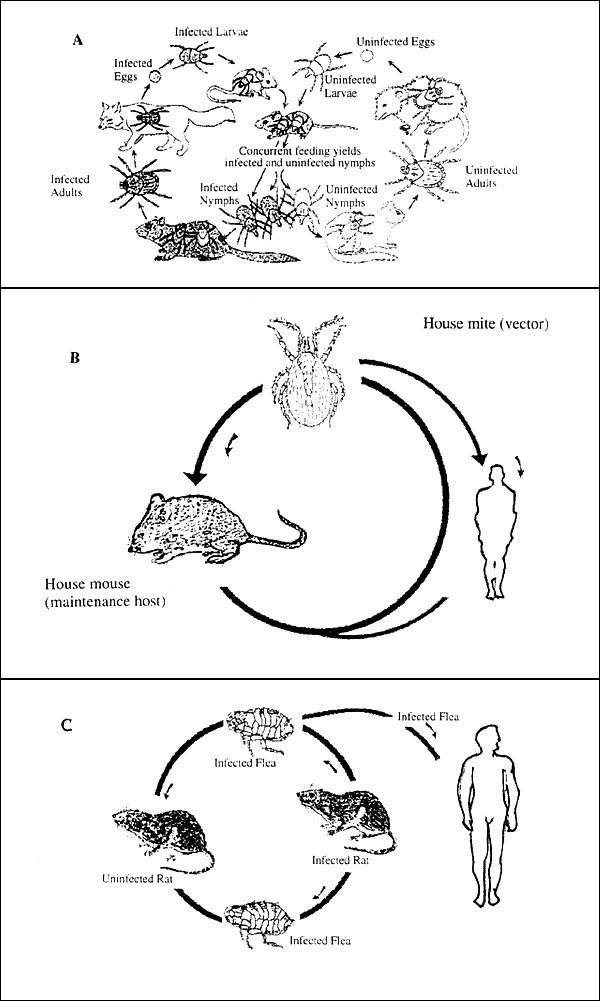Volume 4, Number 2—June 1998
Perspective
Rickettsial Pathogens and Their Arthropod Vectors
Figure

Figure. Composite diagram of the life cycle of Rocky Mountain spotted fever, rickettsialpox, and murine typhus. A. Life cycle of Rickettsia rickettsii in its tick and mammalian hosts (7); B. Rickettsia akari life cycle; and C. Rickettsia typhi life cycle.
References
- Zinsser H. Rats, lice and history. Boston: Little, Brown and Co.;1934.
- Raoult D, Roux V, Ndihokubwayo JB, Bise G, Baudon D, Martet G, Jail fever (epidemic typhus) outbreak in Burundi. Emerg Infect Dis. 1997;3:357–60. DOIPubMedGoogle Scholar
- Walker DH, Barbour A, Oliver JH, Dumler JS, Dennis DT, Azad AF, Emerging bacterial zoonotic and vector-borne diseases: prospects for the effects on the public health. JAMA. 1996;275:463–9. DOIPubMedGoogle Scholar
- Werren JH. Biology of Wolbachia. Annu Rev Entomol.;199742:587–609.
- Azad AF. Relationship to vector biology and epidemiology of louse and flea-borne rickettsioses. In: Walker DH, editor. Biology of rickettsial diseases. Boca Raton (FL): CRC Press; 1988. p. 52-62.
- La Scola B, Raoult D. Laboratory diagnosis of rickettsioses: current approaches to diagnosis of old and new rickettsial diseases. J Clin Microbiol. 1997;35:2715–27.PubMedGoogle Scholar
- McDade JE, Newhouse VF. Natural history of Rickettsia rickettsii. Annu Rev Microbiol. 1986;40:287–309. DOIPubMedGoogle Scholar
- Burgdorfer W. Ecological and epidemiological consideration of Rocky Mountain spotted fever and scrub typhus. In: Walker DH, editor. Biology of Rickettsial Diseases. Boca Raton (FL): CRC Press; 1988. p. 33-50.
- Schriefer ME, Azad AF. Ecology and natural history of Rickettsia rickettsii. In: Sonenshine DE, Mather TN, editors. Ecological dynamics of tick-borne zoonoses. Oxford: Oxford University Press;1994.
- Burgdorfer W, Brinton PL. Mechanisms of transovarial infection of spotted fever rickettsiae in ticks. Ann N Y Acad Sci. 1975;266:61–72. DOIPubMedGoogle Scholar
- Niebylski ML, Schrumpf ME, Burgdorfer W, Fischer ER, Gage KL, Schwan TG. Rickettsia peacockii sp nov., a new species infecting wood ticks, Dermacentor andersoni, in western Montana. Int J Syst Bacteriol. 1997;47:446–52. DOIPubMedGoogle Scholar
- Traub R, Wisseman CL Jr, Azad AF. The ecology of murine typhus: a critical review. Trop Dis Bull. 1978;75:237–317.PubMedGoogle Scholar
- Azad AF, Radulovic S, Higgins JA, Noden BH, Troyer MJ. Flea-borne rickettsioses: some ecological considerations. Emerg Infect Dis. 1997;3:319–28. DOIPubMedGoogle Scholar
- Azad AF, Sacci JB Jr, Nelson WM, Dasch GA, Schmidtman ET, Carl M. Genetic characterization and transovarial transmission of a novel typhus-like Rickettsia found in cat fleas. Proc Natl Acad Sci U S A. 1992;89:43–6. DOIPubMedGoogle Scholar
- Azad AF, Traub R, Baquar S. Transovarial transmission of murine typhus rickettsiae in Xenopsylla cheopis. Science. 1985;227:543–5. DOIPubMedGoogle Scholar
- Adams WH, Emmons RW, Brooks JE. The changing ecology of murine (endemic) typhus in southern California. Am J Trop Med Hyg. 1970;19:311–8.PubMedGoogle Scholar
- McDade JE, Shepard CC, Redus MA, Newhouse VF, Smith JD. Evidence of Rickettsia prowazekii infection in the United States. Am J Trop Med Hyg. 1980;29:277–84.PubMedGoogle Scholar
- Dumler JS, Taylor JP, Walker DH. Clinical and laboratory features of murine typhus in Texas, 1980 through 1987. JAMA. 1991;266:1365–70. DOIPubMedGoogle Scholar
- Williams SG, Sacci JB Jr, Schriefer ME, Anderson EM, Fujioka K, Sorvilo FJ, Typhus and typhus-like rickettsiae associated with opossums and their fleas in Los Angeles County, California. J Clin Microbiol. 1992;30:1758–62.PubMedGoogle Scholar
- Sorvillo FJ, Gondo B, Emmons R, Ryan P, Waterman SH, Tilzer A, A suburban focus of endemic typhus in Los Angeles County: association with seropositive domestic cats and opossums. Am J Trop Med Hyg. 1993;48:269–73.PubMedGoogle Scholar
- Schriefer ME, Sacci JB Jr, Dumler JS, Bullen MG, Azad AF. Identification of a novel rickettsial infection in a patient diagnosed with murine typhus. J Clin Microbiol. 1994;32:949–54.PubMedGoogle Scholar
- Schriefer ME, Sacci JB Jr, Higgins JA, Taylor JP, Azad AF. Murine typhus: updated role of multiple urban components and a second typhus-like rickettsiae. J Med Entomol. 1994;31:681–5.PubMedGoogle Scholar
- Higgins JA, Radulovic S, Schriefer ME, Azad AF. Rickettsia felis: a new species of pathogenic rickettsia isolated from cat fleas. J Clin Microbiol. 1996;34:671–4.PubMedGoogle Scholar
- Noden BH, Radulovic S, Higgins JA, Azad AF. Molecular identification of two closely related rickettsial species, Rickettsia typhi and R. felis, in individual cat fleas, Ctenocephalides felis (Siphonaptera: Pulicidae). J Med Entomol. 1998. In press.PubMedGoogle Scholar
- Pancholi P, Kolbert CP, Mitchell PD, Reed KD, Dumler JS, Bakken JS, Ixodes dammini as a potential vector of human granulocytic ehrlichiosis. J Infect Dis. 1995;:1007–12.PubMedGoogle Scholar
- Werren JH, Hurst GDD, Zhang W, Breeuwer JAJ, Stouthamer R, Majerus MEN. Rickettsial relative associated with male killing in the ladybird beetle (Adalia bipunctata). J Bacteriol. 1994;176:388–94.PubMedGoogle Scholar
- Higgins JA, Sacci JB Jr, Schriefer ME, Endris RG, Azad AF. Molecular identification of rickettsia-like microorganisms associated with colonized cat fleas (Ctenocephalides felis). Insect Mol Biol. 1994;3:27–33.PubMedGoogle Scholar
- Vaughan JA, Azad AF. Acquisition of murine typhus rickettsiae by fleas. Ann N Y Acad Sci. 1990;590:70–5. DOIPubMedGoogle Scholar
- Munderloh UG, Kurtti TJ. Cellular and molecular interrelationships between ticks and prokaryotic tick-borne pathogens. Annu Rev Entomol. 1995;40:221–43. DOIPubMedGoogle Scholar
Page created: December 14, 2010
Page updated: December 14, 2010
Page reviewed: December 14, 2010
The conclusions, findings, and opinions expressed by authors contributing to this journal do not necessarily reflect the official position of the U.S. Department of Health and Human Services, the Public Health Service, the Centers for Disease Control and Prevention, or the authors' affiliated institutions. Use of trade names is for identification only and does not imply endorsement by any of the groups named above.